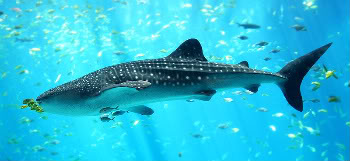|
|
The world’s largest living fish, the whale shark, is threatened by interbreeding, according to a new study in PLoS ONE. Comparing the DNA of 68 individual whale sharks from eleven locations across the globe, geneticists found that the whale sharks had little genetic variation between the populations.
“Our data show that whale sharks found in different oceans are genetically quite similar, which means that animals move and interbreed between populations,” said geneticist Jennifer Schmidt from the University of Illinois at Chicago. “From a conservation standpoint, it means that whale sharks in protected waters cannot be assumed to stay in those waters, but may move into areas where they may be in danger.”
 Captive whale shark in the Georgia aquarium. Photo by: Zac Wolf. |
The massive plankton-eating whale shark is listed as Vulnerable by the IUCN Red List, however some countries still allow it to be hunted meat and shark fin soup, a popular dish in Asia. The lack of knowledge about the whale sharks behavior and reproductive life compounds the problem of conserving the giant animal. Few whale sharks have been studied in the open sea, where they breed and give birth. In addition, the behavior and movements of juvenile whale sharks remains a mystery.
“The only real threat to whale sharks is us,” said Schmidt. “To design proper conservation plans, we need to understand the sharks’ lifestyle. We can only protect their habitat if we know what habitat they use.”
Whale sharks can grow up to 50 feet and weigh over 20 tons They have an estimated lifespan of 70 years and do not reach breeding age until thirty, making any recovery for the species a long process.
Related articles
Sharks in trouble after nations fail to create sustainable management programs
(11/06/2008) Sharks are disappearing from the ocean at startling rates: currently one-in-five of these famous marine predators are threatened with extinction. According to a report from the Australian Government and TRAFFIC—an organization that monitors wildlife trade both legal and illegal—the collapse of shark populations is being caused largely by rising demand for shark fin in Asia. The report shows that legal fishing for sharks has become nearly as detrimental as illegal, since few fisheries have management strategies concerned with sustainability.
The long-ignored ocean emergency and what can be done to address it
(08/18/2008) This year has been full of bad news regarding marine ecosystems: one-third of coral species threatened with extinction, dead-zones spread to 415 sites, half of U.S. reefs in fair or bad condition, increase in ocean acidification, tuna and shark populations collapsing, and only four percent of ocean considered pristine. Jeremy Jackson, director of the Scripps Center for Marine Biodiversity and Conservation at the University of California, San Diego, synthesizes such reports and others into a new paper, published in the journal Proceedings of the Naional Academy of Sciences, that boldly lays out the scope of the oceanic emergency and what urgently needs to be done.
Large shark populations fall 97% in the Mediterranean
(06/12/2008) Populations of some shark species in the Mediterranean have plunged by more than 97 percent over the past 200 years, report researchers writing in the journal conservation Biology. Several species are at risk of extinction.
Fatal San Diego Shark Attack a Rare Event
(04/25/2008) Friday morning a 66-year-old swimmer was attacked and killed by a shark off Solana Beach in San Diego county. It was the first fatal shark attack in San Diego since 1994.
Shark-repelling fishing gear in the works
(04/23/2008) Fishing gear that produces an electric field in sea water could help prevent sharks from becoming accidental bycatch, say scientists at NOAA.
Mysteries of the Great White Shark unveiled
(02/17/2008) The Great White Shark has always been a creature of mystery. The world’s largest shark has long fascinated humanity from the novel and film Jaws to recent sumptuous footage of the sharks catching sea lions in Planet Earth. The behemoth, who at times can reach seven meters in length, has also become famous for occasionally attacking swimmers and surfers, though scientists believe the sharks do not intentionally hunt humans. However, the great predator’s behvaior and lifecycle remains mostly mysterious to science. Some of these mysteries are just now being unraveled thanks to the Tagging of Pacific Predators (TOPP) program.
Sharks do not win CITES protection
(06/08/2007) Two endangered species of sharks failed to win protection at the Convention on International Trade in Endangered Species (CITES) meeting in The Hague.
Shark fin does not cure cancer
(06/03/2007) Shark cartilage, long believed in traditional medicine to be an anti-cancer agent, confers no health benefits in lung cancer survival reports an extensive study presented at the 43rd annual meeting of the American Society of Clinical Oncology. The lead author said the findings cast major skepticism on shark cartilage products that are being sold for profit and have no data to support their efficacy as cancer-fighting agent.
Chinese support shark conservation, but still demand shark fin
(05/25/2007) There is growing public support in China for shark conservation measures, but little understanding of the role of shark finning in declining shark populations, reveals a survey by WildAid, an environmental group.